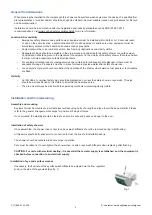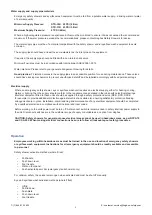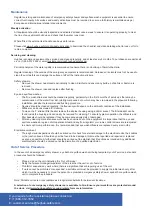
3
T: (1) 866-312-1652
E: customer.service@hughes-safety.com
Emergency safety showers and eye/face wash equipment must be fed from a potable water supply – drinking water or water
of a similar quality.
Minimum Supply Pressure:
STD-32K 29 PSI (2 Bar)
STD-31K 43 PSI (3 Bar)
Maximum Supply Pressure:
87 PSI (6 Bar)
Where a high unregulated pressure is experienced, this must be monitored to ensure it does not exceed the recommended
maximum. If the water pressure exceeds the recommendations, please contact Hughes Safety Showers for advice.
The water supply pipe must be of a material compatible with the safety shower and/or eye/face wash equipment to avoid
corrosion.
The supply pipe should have at least the same diameter as the inlet pipe on the equipment.
If required, the supply pipe should be fitted with a non-return check valve.
Minimum flow rates must be in accordance with International, ANSI Z358.1-2014.
Water inlet size: Please refer to your general arrangement drawing for details.
Good practice:
Fit isolation valves to the supply pipes in an accessible position for use during maintenance. These valves
should have locking mechanisms to prevent unauthorised shutoff and be labelled accordingly with fixed permanent tags.
Where an emergency safety shower, eye or eye/face wash unit requires an electrical supply, either for heating, cooling,
alarms or lighting, then the supply should conform to the requirements as detailed in the job specific electrical drawings.
Electrical equipment fitted to these units should be supplied through a safety protection device (MCB, RCD, RCCB
for example) to provide additional protection against electric shock while also ensuring satisfactory protective bonding
arrangements are in place. Installation, commissioning and maintenance of any electrical equipment should be completed
by a qualified electrician in compliance with all national and local codes.
Before working on the units power must be turn off. A disconnect switch is recommended to safely interrupt power supply to
the unit. Disconnect switches are in the customer scope of supply or available as an option from Hughes.
CAUTION: Safety showers for general purpose electrical areas cannot be used in hazardous areas, as per NFPA 70
and CSA 22.2. When making electrical connections be sure to follow all lockout-tag out safety procedures.
Water supply and supply pipe materials
Electrical supply
Operation
Employees working within hazardous areas must be trained in the use and location of emergency safety showers
or eye/face wash equipment. Instructions for all emergency equipment should be readily available and accessible
to personnel.
Safety shower activation methods (where fitted):
•
Pull handle
•
Push down lever
•
Foot treadle
•
Walk on foot panel
•
Push activated panic bar (emergency tank showers only)
For optimum safety, the valves remain open when activated and must be shut off manually.
Eye and eye/face wash activation methods (where fitted):
•
Lift lid
•
Pull lid down
•
Push plate
•
Push down lever
•
Foot treadle






















